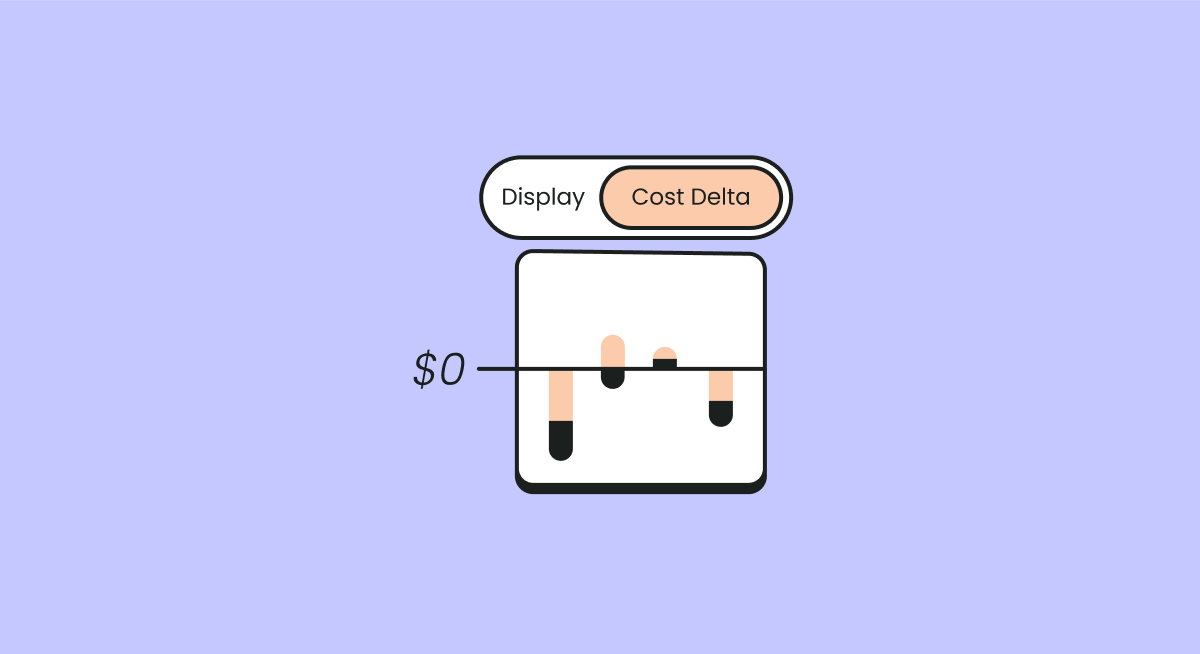
What Is the Rule of 40 for SaaS?
The Rule of 40 is a performance metric used in Software as a Service (SaaS) companies to evaluate the balance between growth and profitability. It is calculated by adding the company's revenue growth rate to its profit margin. If the sum equals or exceeds 40%, the company is considered to have a healthy performance.
This metric, introduced in 2015 by Brad Feld, a venture capitalist, helps investors and executives make decisions about where to allocate resources and how to structure the business for optimal growth and profitability.
While not an absolute measure, the Rule of 40 provides a quick snapshot of a company's operational health. Given the dynamic nature of SaaS businesses, achieving the right balance between high growth and sustainable profitability can be challenging. The Rule of 40 serves as a guidepost, helping companies balance expansion with financial stability.
This is part of a series of articles about cloud cost management.
Related content:
Why Is the Rule of 40 Important in SaaS?
Calculating Affordability
Calculating affordability within the context of the Rule of 40 involves assessing whether a company can grow sustainably without running into financial distress. This includes evaluating current revenue, profit margins, and growth prospects. Understanding these factors helps a SaaS company determine if it can maintain its desired growth rate while still keeping an eye on profitability.
Affordability also ties into how resources are allocated for growth. SaaS companies must carefully consider investments in areas like customer acquisition, product development, and employee expansion. Ensuring these investments do not drastically harm profit margins allows the company to stay within the Rule of 40 guidelines, balancing growth and fiscal health.
Decreasing Focus on Profit
In the early stages of a SaaS business, the focus is often heavily skewed towards growth, sometimes at the expense of profitability. Decreasing focus on profit makes sense as fostering growth can lead to substantial market share gains. Companies might sacrifice short-term profits to build a customer base and refine their product offerings.
However, this growth-first mindset must be mitigated by a focus on eventual profitability. The Rule of 40 helps keep this balance in check. While high growth rates may initially justify lower profits, later in a company’s life, the Rule of 40 metric ensures that the long-term viability of the business model is not compromised.
Investment Quality Comparisons
The Rule of 40 serves as a tool for comparing the investment quality of different SaaS companies. By simplifying performance metrics into a single composite number, it allows investors to quickly assess which companies are balancing growth and profitability most effectively. This can be particularly useful in making investment choices in a crowded market.
Investment quality comparisons are crucial in allocating capital efficiently. Companies that consistently meet or exceed the Rule of 40 are often deemed less risky and more promising, as they exhibit both growth and sound financial management.
Changing Between Growth and Profitability
Transitioning between a focus on growth and profitability is a challenging yet essential aspect of scaling a SaaS company. Earlier stages may emphasize rapid growth, making significant investments in customer acquisition and market expansion. However, as the company matures, there often needs to be a pivot towards improving profit margins without stalling growth momentum.
Balancing this transition is where the Rule of 40 becomes particularly useful. It provides a framework for shifting priorities without losing sight of fundamental business health. Companies that master this balance can adapt more fluidly to market demands and opportunities, thereby sustaining long-term success.
How to Calculate the SaaS Rule of 40
To calculate the SaaS Rule of 40, first determine the company’s annual revenue growth rate. This is typically expressed as a percentage and calculated by comparing the company's current annual revenue to its revenue from the previous year.
Next, find the company's profit margin, which can be measured using earnings before interest, taxes, depreciation, and amortization (EBITDA) margin, operating margin, or net margin, depending on the company's reporting preference.
Once both figures are obtained, simply add the revenue growth rate to the profit margin percentage. If the total is 40% or higher, the company meets the Rule of 40 standard, indicating a balanced approach to growth and profitability. For example, a company with a 25% growth rate and a 15% profit margin achieves a Rule of 40 score of 40%.
SaaS Rule of 40 Calculation Examples
Example 1: A Company Meeting the Rule of 40
Consider a SaaS company called TechGrow that has shown significant growth over the past year. TechGrow's annual revenue growth rate is 30%, and it has a profit margin of 15%.
To calculate TechGrow's Rule of 40 score, add the revenue growth rate to the profit margin:
- Revenue growth rate: 30%
- Profit margin: 15%
- Rule of 40 score: 30% + 15% = 45%
With a Rule of 40 score of 45%, TechGrow exceeds the benchmark of 40%, indicating a strong balance between growth and profitability.
Example 2: A Company Not Meeting the Rule of 40
Now, let's look at another SaaS company, CloudSync, which has focused heavily on expanding its market share. CloudSync's annual revenue growth rate is 25%, but due to high operating costs, it has a profit margin of only 5%.
Calculating CloudSync's Rule of 40 score gives us:
- Revenue growth rate: 25%
- Profit margin: 5%
- Rule of 40 score: 25% + 5% = 30%
With a Rule of 40 score of 30%, CloudSync falls short of the 40% benchmark. This lower score indicates that while CloudSync is growing, it is not doing so in a financially sustainable way. The company may need to re-evaluate its spending and operational efficiency.

In my experience, here are tips that can help you better adapt to using the Rule of 40 in SaaS:
- Incorporate customer lifetime value (LTV): Consider integrating Customer Lifetime Value into your analysis. High LTV in combination with meeting the Rule of 40 can signal sustainable growth driven by customer loyalty and retention, not just rapid acquisition.
- Adjust for churn impact: Factor in customer churn when calculating the Rule of 40. High churn can artificially inflate your growth rate, masking potential long-term issues in customer retention and profitability.
- Account for non-recurring revenue: Isolate recurring revenue from non-recurring revenue when calculating the Rule of 40. Non-recurring revenue can distort the true growth and profitability trends in subscription-based businesses.
- Stress-test with different scenarios: Use different growth and profit margin scenarios to stress-test your Rule of 40 performance. This can help you understand how sensitive your business model is to changes in market conditions or internal cost structures.
- Align with product development cycles: Map the Rule of 40 against your product development cycle stages. Early-stage products might negatively impact margins but could drive future growth; understanding this helps manage expectations and strategy.
How Many SaaS Companies Meet the Rule of 40?
Achieving the Rule of 40 is challenging for many SaaS companies, especially those in earlier stages of growth where the focus tends to be on scaling rapidly, often at the expense of profitability. According to the KeyBanc Private SaaS Company Survey, only 32% of surveyed SaaS companies with Annual Recurring Revenue (ARR) of $5 million or more met or exceeded the Rule of 40.
The median score for the group was 25%, indicating that many companies are still working to find the optimal balance between growth and profitability. These figures underscore the importance of strategic financial planning and operational efficiency for SaaS companies.
The image below shows a plot of public SaaS companies, showing their profit margin, revenue growth, and compliance with the Rule of 40.
When to Use The Rule Of 40
The application of the Rule of 40 depends on a SaaS company’s maturity and strategic goals:
- Early-stage companies: For early-stage SaaS companies, the focus is typically on rapid growth. These companies may prioritize increasing their customer base and expanding market share, even if it means operating at a loss. At this stage, the Rule of 40 can still serve as a long-term target, helping to guide decisions toward eventual profitability. While these companies may not meet the Rule of 40 initially, keeping it in mind ensures that they don’t stray too far from a sustainable growth path.
- Growth-stage companies: As SaaS companies mature and move into the growth stage, they often begin to shift their focus from pure growth to a more balanced approach that includes profitability. This is where the Rule of 40 becomes particularly relevant. It can be used to evaluate whether the company is successfully transitioning from a growth-first strategy to one that also emphasizes financial health. For these companies, consistently meeting or exceeding the Rule of 40 indicates a well-managed balance between scaling operations and maintaining solid profit margins.
- Late-stage and mature companies: For late-stage or mature SaaS companies, the Rule of 40 is a critical metric for assessing ongoing business health. At this stage, companies should ideally be able to achieve both robust growth and solid profitability. Investors and executives use the Rule of 40 to ensure that the company remains competitive and financially stable, even as it scales further or enters new markets.
-
Investment and acquisition decisions: The Rule of 40 is also valuable in the context of investment and acquisition decisions. Investors often use this metric to compare potential investments, especially when evaluating companies at different stages of growth. A company that meets or exceeds the Rule of 40 is generally considered a lower-risk investment, as it demonstrates a healthy balance of growth and profitability.
Limitations of the Rule of 40
While the Rule of 40 is a very useful metric, it has several important limitations.
Simplicity and Limited Scope
The simplicity of the Rule of 40 is both a strength and a weakness. It provides an easy-to-understand benchmark but fails to capture the multifaceted nature of business performance. Important aspects such as operational efficiency, long-term strategic goals, and market dynamics are not included in this singular metric.
Limited scope can lead to overly simplistic evaluations. Relying solely on the Rule of 40 may cause businesses and investors to overlook critical areas that require attention. Comprehensive analysis involving multiple performance indicators should complement the Rule of 40 for a well-rounded understanding of a company's health.
Snapshot in Time
The Rule of 40 provides a snapshot in time, reflecting current performance but not necessarily predicting future success. It may indicate that a company is performing well now, but it does not account for potential future challenges like market saturation, competitive pressures, or changes in customer needs.
Relying too heavily on this metric can lead to complacency. Companies may hit the Rule of 40 in one period but fail to sustain it over the long term. Thus, while useful for a quick assessment, the Rule of 40 should be part of a broader, ongoing evaluation process to inform long-term strategy.
Capital Efficiency
The Rule of 40 does not address capital efficiency. A company might meet the Rule of 40 by achieving impressive growth and profitability metrics but could still be inefficient in its use of capital. Capital efficiency analysis includes understanding how well the company is using its financial resources to generate returns.
Evaluating capital efficiency ensures that the business systems and processes are optimized for sustainable growth. Investors and executives should consider additional financial metrics that provide insights into the effective use of capital alongside the Rule of 40. This holistic approach ensures a comprehensive understanding of the company's financial health.
Cloud Cost Management for SaaS with Finout
Cloud cost management is a crucial component in the financial health of SaaS companies, especially when striving to meet the Rule of 40. With Finout, SaaS businesses gain deep visibility into their cloud spend, enabling them to optimize costs and maintain profitability without sacrificing growth. By leveraging Finout’s comprehensive cost allocation and financial planning tools, SaaS companies can align their operational efficiency with strategic goals, ensuring that they meet the Rule of 40 benchmark. Finout’s platform provides a seamless approach to managing cloud costs, helping SaaS companies achieve a balanced, sustainable growth trajectory.








